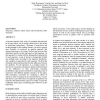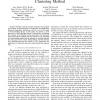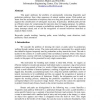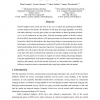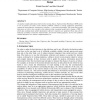126
Voted
JIPS
2010
14 years 7 months ago
2010
Spatio-temporal patterns extracted from historical trajectories of moving objects reveal important knowledge about movement behavior for high quality LBS services. Existing approac...
173
Voted
GAMEON
2009
14 years 10 months ago
2009
At present, trajectory data, series of coordinate data traversed by moving objects, can be readily obtained due to the advent of positioning technologies. Clustering of trajectori...
92
Voted
WAIM
2010
Springer
14 years 10 months ago
2010
Springer
Trajectory prediction (TP) of moving objects has grown rapidly to be a new exciting paradigm. However, existing prediction algorithms mainly employ kinematical models to approximat...
114
Voted
IS
2010
14 years 11 months ago
2010
—Existing works for semantic trajectory data analysis have focused on the intersection of trajectories with application important geographic information and the use of the speed ...
95
Voted
SAC
2008
ACM
14 years 12 months ago
2008
ACM
We address aggregate queries over GIS data and moving object data, where non-spatial information is stored in a data warehouse. We propose a formal data model and query language t...
94
Voted
IVC
2002
15 years 3 days ago
2002
This paper addresses the problem of automatically extracting frequently used pedestrian pathways from video sequences of natural outdoor scenes. Path models are learnt from the ac...
99
Voted
SIGKDD
2008
15 years 10 days ago
2008
Advances in telecommunications and GPS sensors technology have made possible the collection of data like time series of locations, related to the movement of individuals. The anal...
117
click to vote
GEOINFORMATICA
2007
15 years 11 days ago
2007
Nearest Neighbor (NN) search has been in the core of spatial and spatiotemporal database research during the last decade. The literature on NN query processing algorithms so far d...
119
Voted
JIIS
2006
15 years 12 days ago
2006
Spatio-temporal, geo-referenced datasets are growing rapidly, and will be more in the near future, due to both technological and social/commercial reasons. From the data mining vie...
112
click to vote
CORR
2010
Springer
15 years 16 days ago
2010
Springer
To analyze complex phenomena which involve moving objects, Trajectory Data Warehouse (TDW) seems to be an answer for many recent decision problems related to various professions (...

